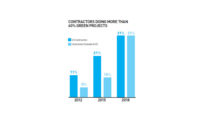
Green building is becoming an increasingly important aspect of construction in the retail and hotel sectors, says a recent study from McGraw Hill Construction—like ENR, a unit of McGraw Hill Financial. Fifty-two percent of retail and restaurant owners say that, within the next two years, more than half their projects will be green, up from a current 38%, and 64% of hotel owners report the same, up from 48%. The study was published this summer in McGraw Hill Construction's "Green Retail and Hospitality SmartMarket Report" in partnership with Waste Management.
For contractors that compete in these marketplaces, the past few years have made green building an essential part of their business strategy, rather than a niche.
While the report focused mostly on building owners, the study also surveyed 183 contractors that work in the retail and hotel sectors. The contractors said that not only do owners gain strong financial benefits from building green but the contractors themselves also gain much from these jobs.
Also, contractors that collaborated closely with project team members during predesign reported landing higher levels of green work. They also became more aware of what drives owners to build green, giving them an overall competitive advantage.
Contractors and Predesign
Contractors are getting involved earlier in the project life cycle as the industry slowly shifts to a more collaborative approach. The benefits of predesign collaboration are increasingly evident for all types of construction, but it offers specific advantages for green building. These include the project team's improved commitment to sustainable design and a more holistic understanding of building systems. That, in turn, improves building performance and saves energy.
Data collected on green building in the retail, restaurant and hotel sectors showed that contractors engaged in predesign on at least 10% of their projects were doing a higher level of green work. Nearly twice as many firms engaged in predesign were doing green work on more than 30% of their projects, compared with firms less engaged in predesign.
The study does not reveal a specific cause for these results. Do they arise from a greater use of integrated design on green projects, more interest in integrated design by green contractors, or both? But the study does demonstrate a strong corollary between contractor engagement in green work and collaboration in project delivery.
A likely advantage that contractors find in predesign collaboration on all types of construction is a better understanding of the owner's priorities. The study confirms this benefit in green projects.
The findings demonstrate that contractors engaged in predesign on 10% or more of their projects are much closer to the owners' perceptions of these factors than contractors not involved in predesign. This is particularly true for contractors working on green retail projects.
Despite the difference, however, a higher percentage of contractors in the retail sector consider sustaining or improving business volume (45%) and brand or public relations advantages (41%) more influential than human-impact benefits (30%).
In contrast, a higher percentage of owners (44%) consider human impact an important green driver compared to the other two factors.





